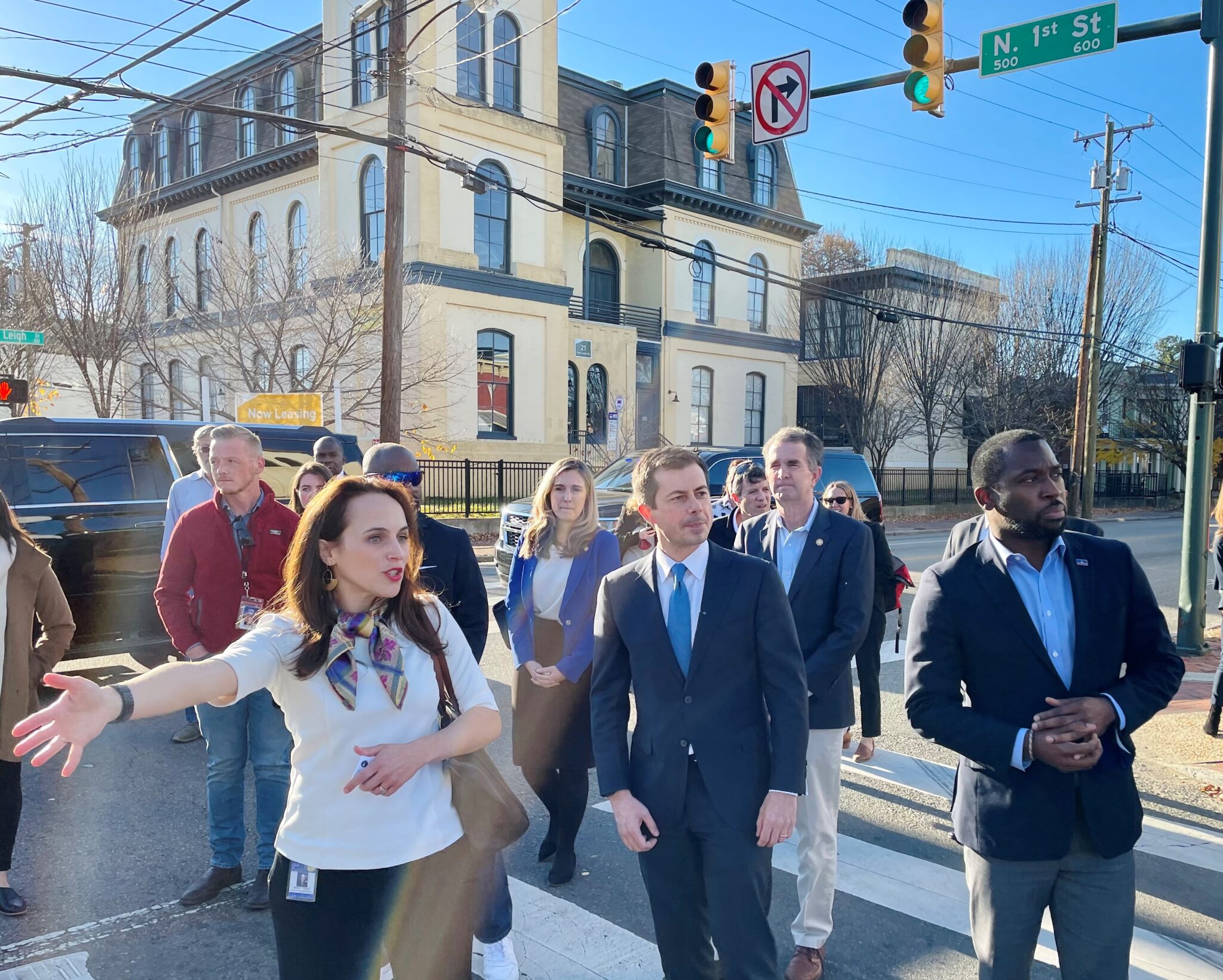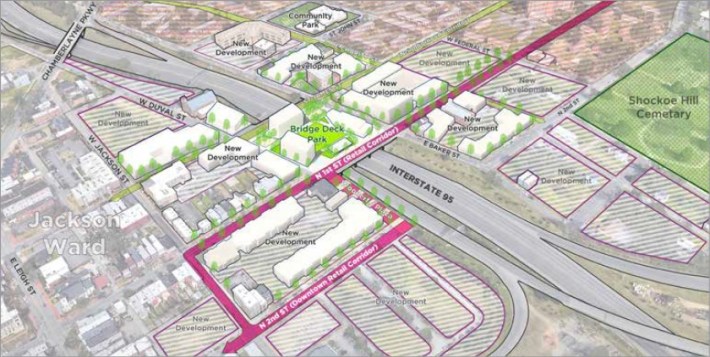Could Biden’s Infrastructure Bill Help Heal the Scars Highways Created?
12:01 AM EST on December 13, 2021

U.S. Transportation Secretary Pete Buttigieg, center, takes a tour of Richmond’s Jackson Ward Neighborhood, accompanied by Mayor Levar Stoney (right) and Maritza Mercado Pechin, (left) a city planning official. Image courtesy Wyatt Gordon for the Virginia Mercury)
Editor's Note: This article originally appeared by the Virginia Mercury and is republished with permission.
From the interstate highway system to public housing, some of America’s most discriminatory and damaging policies have been implemented under the auspices of the need for better infrastructure. That’s why U.S. Secretary of Transportation Pete Buttigieg made his first stop on a Virginia visit to tout the Democrats’ Infrastructure Investment and Jobs Act a walking tour of Jackson Ward — a Richmond neighborhood known as “the Harlem of the South,” devastated in the 1950s by the construction of Interstate 95.
“Transportation is about connection,” said Buttigieg. “What you see in Jackson Ward is how transportation dollars can disconnect communities. What you see is a community cut through by a highway. Whether it’s through more crossings or capping the highway, transportation should always be about connecting and not dividing. Twenty-first century planning has to be about how any new transportation asset is integrating the surrounding areas. How do we knit it all together in a way that benefits all?”
.@CityRichmondVA's Jackson Ward neighborhood has served as a center of Black commerce and culture for 150 years. But it's also an example of past transportation policy gone wrong 🧵 pic.twitter.com/ymeyRog1UJ
— Secretary Pete Buttigieg (@SecretaryPete) December 3, 2021
Initially constructed by city and state leaders as the Richmond-Petersburg Turnpike, the highway corridor through the heart of Virginia’s capital destroyed around 1,000 homes and businesses in favor of an interstate to serve largely white commuters fleeing to the suburbs. Instead of following the natural contours of Shockoe Valley around Richmond’s downtown, transportation planners intentionally targeted the financial and cultural heart of Black Richmond: Jackson Ward. By the time I-95 was completed, roughly 10 percent of the city’s Black population had been displaced due to the demolitions.
Atonement through investment
Seeking to deliver on a campaign promise to usher in more equitable government intervention in Americans’ lives — and especially those of people of color, the new federal infrastructure bill dedicates $1 billion for highway capping and removal. Even at only 5 percent of the original proposal for $20 billion, the new funding could prove transformational if focused on just a few communities across the country.
“We’re talking about over a billion dollars for communities like Jackson Ward in terms of reconnecting them,” said U.S. Rep. Donald McEachin, D-Richmond. “We as a government — whenever and wherever we can — need to make up for and correct past wrongs. It’s not enough to just say, ‘I’m sorry.’ You have to back up regret with restorative actions. This is a way for us as a nation to atone for what we did to that community and help current residents come together and be that vibrant hub of entertainment, busines, and culture again that it once was.”
While leading the walking tour with Secretary Buttigieg, Maritza Pechin — deputy director of the city’s Office of Equitable Development — pointed out just how isolating the highway is. The 2,522 residents of Gilpin Court (increasingly referred to by city officials as “North Jackson Ward”) have just two roads that connect them south to the rest of the city. Upon being informed that an I-95 off-ramp funnels drivers directly into Gilpin without even offering residents an on-ramp to access the interstate themselves, Buttigieg responded, “This is embarrassing.”
To suture the neighborhood back together, this summer the city’s Richmond 300 master planning process proposed a one-block cap over I-95 that would add new greenspace to the area and restore the connection of St. James Street south. The plan also recommended the city explore two more block-long caps of the highway at Second and Seventh Streets to increase connectivity further.
Redress via redevelopment?
Richmond 300 describes the bridge decks reconnecting Jackson Ward as one of just six “Big Moves” the city could make to achieve its broader goals in the plan on housing, greenspace and more due to the wave of redevelopment such a transformative project would likely trigger. With the city’s support, the Richmond Redevelopment and Housing Authority recently won a $450,000 planning grant from the Department of Housing and Urban Development to reimagine Gilpin Court’s public housing as a mixed-use, mixed-income development.

“We worked with RRHA to make them competitive for that grant,” said Richmond Mayor Levar Stoney. “There’s been some failures in the past, but this one shows real promise for the residents of Gilpin. We want to deconcentrate poverty because we know these conditions are not the sort anyone in this city should be living in. Gilpin will soon be 80 years old and Creighton is close to 70 with no major overhaul of these properties for decades. The time has come for us to do something.”
Lacking a one-for-one replacement guarantee from RRHA, Gilpin residents and housing advocates have expressed concern the redevelopment of the area could simply displace existing residents in favor of new, wealthier ones. Despite such fears, local officials believe the capping of I-95 would be an overall win for public housing residents and the city as a whole.
“We are very excited this could be a reality as part of the redevelopment of Gilpin,” said Barrett Hardiman, RRHA’s vice chairman and head of the authority’s real estate committee. “The two halves of the neighborhood should be reconnected. We’re trying to come up with a redevelopment plan that will help meet the city’s goal of 10,000 new affordable units and we need to evaluate what part of that is ours and what the market can provide.”
Given Richmond’s abysmal record of following through on promises of replacement public housing, it’s no wonder residents are worried. McEachin feels confident that with federal backing this time can be different. “There’s a lot of excitement and some trepidation that Washington could come in and do something without listening to them. We want to make sure our constituents know this is going to be done with their wishes and needs at the forefront.”
Quick versus right
As the Democrats bet their hopes for maintaining their congressional majority in 2022 on the success of this historical investment in infrastructure, the tension between rapidly distributing the funding and ensuring the spending is effective is palpable.
“We are very mindful of the need to balance getting it out quickly and getting it out right,” Buttigieg said during the second half of his visit at a road construction site in Henrico County. “One of the most important things is engagement from day one to make sure these investments are not done to communities but by and with them. If we get this right, this will create value for those communities, businesses and people who have been there all along and not just the new folks who are going to join them.”
With $1.2 trillion in new spending in the bipartisan infrastructure bill on everything from Amtrak and public transit to bridge repairs and road expansions, ensuring equitable engagement surrounding such huge investments will be no easy feat. With 577 bridges and over 2,124 miles of highway in poor condition across the commonwealth, however, the funding can’t come too soon according to bill backers like U.S. Rep. Abigail Spanberger, D-Henrico.
“It’s an issue of our competitiveness, of pivoting towards the future, creating jobs, and expanding the literal connections between our people,” Spanberger said. “When we talk about roads, bridges and broadband, this is such a basic element of our country’s physical infrastructure. I’m glad we demonstrated the value of responsible governing. This is housekeeping we should have done years ago.”
Despite the vast sums included in the deal brokered between President Joe Biden and Congress, the scope of the national need for highway capping and removal may prove overwhelming. Tearing out an expressway which decimated the Tremé neighborhood of New Orleans has been estimated to cost $500 million alone. Filling in two thirds of a mile of interstate in Rochester and establishing a new urban neighborhood on top cost just $22 million for comparison. A one-block capping of I-95 would likely prove even cheaper.

Acknowledging that almost every city across America has its own story — if not multiple — similar to what happened to Jackson Ward, Buttigieg framed the $1 billion for reconnecting communities as a first step towards restoration. “I would characterize it as a beginning,” he said. “We have to demonstrate the effectiveness of these strategies and then we will get more money to keep going.”
In that fight he has an ally in McEachin, for whom the restoration of Jackson Ward is also personal: “That church at St. James and Leigh Street was my grandfather’s church. My family has been in this area for generations since right after the Revolutionary War.”
That’s why McEachin recently submitted a letter with Maryland Congressman Anthony Brown requesting even more funding for the recently passed highway removal program. “We know there are many areas across the nation that have faced similar challenges that have to be tended to as well,” said McEachin. “Jackson ward is not the only one. It’s going to take a lot more money to fix these wrongs than this initial down payment.”
Wyatt Gordon covers transportation, housing, and land use for the Virginia Mercury through a grant from the Piedmont Environmental Council and the Coalition for Smarter Growth. Previously he’s written for the Times of India, Nairobi News, Honolulu Civil Beat, Style Weekly and RVA Magazine. He also works as a policy manager for land use and transportation at the Virginia Conservation Network.
Read More:
Stay in touch
Sign up for our free newsletter
More from Streetsblog USA
How Car-Centric Cities Make Caring For Families Stressful — Particularly For Women
Women do a disproportionate share of the care-related travel their households rely on — and car-focused planning isn't making matters easier.
Wednesday’s Headlines Build Green
A new bill dubbed "Build Green" would replace many of the climate-friendly elements Sen. Joe Manchin insisted on stripping from the Inflation Reduction Act.
E-Bikes and Creating Financially Sustainable Bike Share Programs
The number of customers using bike share in the U.S. and Canada is now at an all-time high thanks to e-bikes.
Tuesday’s Headlines Pick the Low-Hanging Fruit
Greg Shill argues that if a transformative road redesign isn't possible, it's time to talk about second-best strategies.
How to Fight a Texas-Sized Freeway Battle
A new book explores how Texas advocates are fighting back against destructive highway expansions. But what happened to those projects since it was sent to the printer?




